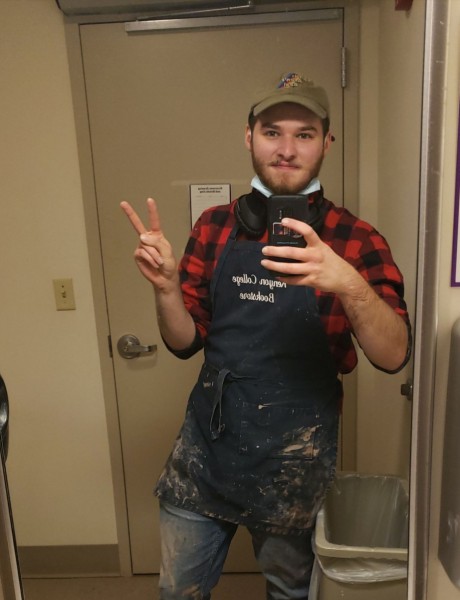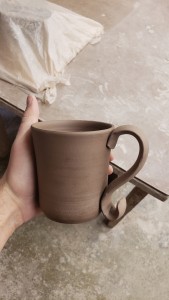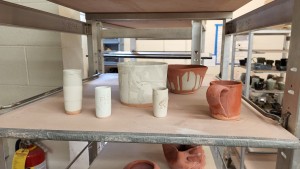Whenever I worked in the studio, I thought about Terra Incognito. The parallels were plentiful, and they warmed me on cold days. The familiar whir of the wheels. The sounds of clay slamming on the tables as people wedge. The chirping of the fans. I used to feel bad, earlier in the semester, when I would sneak out in the late hours of the night, hugging myself for warmth as I walked through the winter air, hung my jacket up in the studio, wedged some clay, and got down to work. Below is an abridged list that summarizes the experience of wheel throwing.
-
You do not look away. I have seen people look away from their pots while they raise the walls, but that has always been beyond me. In order to raise the walls without throwing the whole piece off center, it requires a level of supreme concentration and flow that I don't think I'm really able to tap into at any other point. It forces you to be present and live in the moment, because if you don't — if you let your mind slip into the past or future or anywhere else — you not only lose all your hard work, but risk getting slapped by a flying pot while you're at it.
-
You will get filthy. Beyond the pleasure of looking kind of cool covered in clay (even though nobody wants to admit it), it’s nice to be able to say screw it and forgive yourself for messing up those pants or that nice white shirt. Like a mud bath, there is something wonderful about smearing wet clay all over your jeans without a second thought — and nobody looks at you like you're a madman. In the studio, being a pig is normalized, and even encouraged.
When essays and homework came to be too much this semester, just as it was in middle school nearly 10 years ago (scary to think!), pottery came swooping in to save my mental health. But there was a tinge of regret, because with every moment I spent working, there was a paper I could have been writing, a test I could have been studying for, or sleep I could’ve been trying harder to get. I stopped feeling bad two days ago.
too much this semester, just as it was in middle school nearly 10 years ago (scary to think!), pottery came swooping in to save my mental health. But there was a tinge of regret, because with every moment I spent working, there was a paper I could have been writing, a test I could have been studying for, or sleep I could’ve been trying harder to get. I stopped feeling bad two days ago.
I’m an anthropology major, and one of my friends and fellow anth majors was talking to me about a class she is taking with Professor Novotny called Engaged Archaeology. For one of the final projects, students are writing papers researching Kenyon's early history through the archaeological record. This friend of mine was focusing her research on one particular artifact that was found on the site of what was once the house of Philander Chase, Kenyon’s founder. Now, it is a patch of grass. The artifact was a couple small potsherds, which is exactly what it sounds like phonetically: shards of a pot. She asked me to take a look at it, because she'd been working on it for several days, and could not, for the life of her, identify what it was. She told me it could be white stoneware, creamware, any number of things.
I looked at the potsherds.
I eyed the glaze.
I thought for a moment.
"Yeah, dude, that's celadon. Creamware with a celadon glaze. Take a look."
I pulled out my phone and showed her a photo of what creamware looks like when celadon glaze is applied. The colors were identical. As if they could have been from the very same pot. I had cracked the case.
She's citing me as a source in her paper. A decade of experience in pottery paid off where I never expected. As an aspiring archaeologist myself, I feel like this bodes well. Beyond the uncontrollable thrill of "doing" archaeology for the first time — I identified a previously unidentified artifact using expertise that I had! — it showed me that maybe taking time for myself and doing things I enjoy isn't, in fact, the opposite of productivity and learning. Even when I'm having fun and taking a breather, I'm learning and experiencing, and in that sense, there's no such thing as being unproductive. I might even venture so far as to say that pursuing mental health and some peace and quiet every few nights is productive in its own right, even if it weren't the key to cracking some fascinating archaeological mystery. In college, you'll find that your interests and passions play into one another in new and exciting ways, and building bridges between them can be a magical experience.
A decade of experience in pottery paid off where I never expected. As an aspiring archaeologist myself, I feel like this bodes well. Beyond the uncontrollable thrill of "doing" archaeology for the first time — I identified a previously unidentified artifact using expertise that I had! — it showed me that maybe taking time for myself and doing things I enjoy isn't, in fact, the opposite of productivity and learning. Even when I'm having fun and taking a breather, I'm learning and experiencing, and in that sense, there's no such thing as being unproductive. I might even venture so far as to say that pursuing mental health and some peace and quiet every few nights is productive in its own right, even if it weren't the key to cracking some fascinating archaeological mystery. In college, you'll find that your interests and passions play into one another in new and exciting ways, and building bridges between them can be a magical experience.
Here's to many more late nights in the pottery studio, to a peaceful end to the semester, and to learning with every step we take — whether we mean to or not.

 too much this semester, just as it was in middle school nearly 10 years ago (scary to think!), pottery came swooping in to save my mental health. But there was a tinge of regret, because with every moment I spent working, there was a paper I could have been writing, a test I could have been studying for, or sleep I could’ve been trying harder to get. I stopped feeling bad two days ago.
too much this semester, just as it was in middle school nearly 10 years ago (scary to think!), pottery came swooping in to save my mental health. But there was a tinge of regret, because with every moment I spent working, there was a paper I could have been writing, a test I could have been studying for, or sleep I could’ve been trying harder to get. I stopped feeling bad two days ago. A decade of experience in pottery paid off where I never expected. As an aspiring archaeologist myself, I feel like this bodes well. Beyond the uncontrollable thrill of "doing" archaeology for the first time — I identified a previously unidentified artifact using expertise that I had! — it showed me that maybe taking time for myself and doing things I enjoy isn't, in fact, the opposite of productivity and learning. Even when I'm having fun and taking a breather, I'm learning and experiencing, and in that sense, there's no such thing as being unproductive. I might even venture so far as to say that pursuing mental health and some peace and quiet every few nights is productive in its own right, even if it weren't the key to cracking some fascinating archaeological mystery. In college, you'll find that your interests and passions play into one another in new and exciting ways, and building bridges between them can be a magical experience.
A decade of experience in pottery paid off where I never expected. As an aspiring archaeologist myself, I feel like this bodes well. Beyond the uncontrollable thrill of "doing" archaeology for the first time — I identified a previously unidentified artifact using expertise that I had! — it showed me that maybe taking time for myself and doing things I enjoy isn't, in fact, the opposite of productivity and learning. Even when I'm having fun and taking a breather, I'm learning and experiencing, and in that sense, there's no such thing as being unproductive. I might even venture so far as to say that pursuing mental health and some peace and quiet every few nights is productive in its own right, even if it weren't the key to cracking some fascinating archaeological mystery. In college, you'll find that your interests and passions play into one another in new and exciting ways, and building bridges between them can be a magical experience.